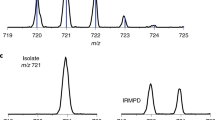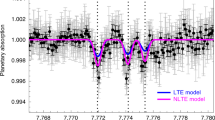Abstract
Highly charged iron (Fe16+, here referred to as Fe xvii) produces some of the brightest X-ray emission lines from hot astrophysical objects1, including galaxy clusters and stellar coronae, and it dominates the emission of the Sun at wavelengths near 15 ångströms. The Fe xvii spectrum is, however, poorly fitted by even the best astrophysical models. A particular problem has been that the intensity of the strongest Fe xvii line is generally weaker than predicted2,3. This has affected the interpretation of observations by the Chandra and XMM-Newton orbiting X-ray missions1, fuelling a continuing controversy over whether this discrepancy is caused by incomplete modelling of the plasma environment in these objects or by shortcomings in the treatment of the underlying atomic physics. Here we report the results of an experiment in which a target of iron ions was induced to fluoresce by subjecting it to femtosecond X-ray pulses from a free-electron laser4; our aim was to isolate a key aspect of the quantum mechanical description of the line emission. Surprisingly, we find a relative oscillator strength that is unexpectedly low, differing by 3.6σ from the best quantum mechanical calculations. Our measurements suggest that the poor agreement is rooted in the quality of the underlying atomic wavefunctions rather than in insufficient modelling of collisional processes.
This is a preview of subscription content, access via your institution
Access options
Subscribe to this journal
Receive 51 print issues and online access
$199.00 per year
only $3.90 per issue
Buy this article
- Purchase on Springer Link
- Instant access to full article PDF
Prices may be subject to local taxes which are calculated during checkout




Similar content being viewed by others
References
Paerels, F. B. S. & Kahn, S. M. High-resolution X-ray spectroscopy with Chandra and XMM-Newton. Annu. Rev. Astron. Astrophys. 41, 291–342 (2003)
Behar, E., Cottam, J. & Kahn, S. M. The Chandra iron-L X-ray line spectrum of Capella. Astrophys. J. 548, 966–975 (2001)
Xu, H. et al. High-resolution observations of the elliptical galaxy NGC 4636 with the reflection grating spectrometer on board XMM-Newton. Astrophys. J. 579, 600–606 (2002)
Emma, P. et al. First lasing and operation of an ångstrom-wavelength free-electron laser. Nature Photon. 4, 641–647 (2010)
Beiersdorfer, P. et al. Measurement of the 3d→2p resonance to intercombination line-intensity ratio in neonlike Fe XVII, Ge XXIII, and Se XXV. Phys. Rev. A 64, 032705 (2001)
Beiersdorfer, P. et al. Laboratory measurements of the Fe XVII 2p-3s and 2p-3d transitions and comparison with solar and astrophysical observations. Astrophys. J. 610, 616–623 (2004)
Parkinson, J. H. New observations of Fe XVII in the solar X-ray spectrum. Astron. Astrophys. 24, 215–218 (1973)
Schmelz, J. T., Saba, J. L. R. & Strong, K. T. Resonance scattering of Fe XVII — a density diagnostic. Astrophys. J. 398, L115–L118 (1992)
Waljeski, K. et al. The composition of a coronal active region. Astrophys. J. 429, 909–923 (1994)
Brown, G. V. et al. Diagnostic utility of the relative intensity of 3C to 3D in Fe XVII. Astrophys. J. 557, L75–L78 (2001)
Brown, G. V. et al. Energy-dependent excitation cross section measurements of the diagnostic lines of Fe XVII. Phys. Rev. Lett. 96, 253201 (2006)
Chen, G.-X. Converged Dirac R-matrix calculation of electron impact excitation of Fe XVII. Phys. Rev. A 76, 062708 (2007)
Nikulin, V. K. & Trzhaskovskaya, M. B. Comment on “Energy-dependent excitation cross section measurements of the diagnostic lines of Fe XVII”. Phys. Rev. Lett. 108, 139301 (2012)
Brown, G. V. & Beiersdorfer, P. Brown and Beiersdorfer reply. Phys. Rev. Lett. 108, 139302 (2012)
Fournier, K. B. & Hansen, S. B. Resolution of the long-standing overprediction of the resonance to intercombination line-intensity ratio in mid-Z neonlike ions. Phys. Rev. A 71, 012717 (2005)
Gu, M. F. New benchmark of X-ray line emission models of Fe XVII. Preprint at http://arXiv.org/abs/0905.0519v1 (2009)
Epp, S. W. et al. Soft X-ray laser spectroscopy on trapped highly charged ions at FLASH. Phys. Rev. Lett. 98, 183001 (2007)
Marrs, R. E., Beiersdorfer, P. & Schneider, D. The Electron Beam Ion Trap. Phys. Today 47, 27–34 (1994)
Epp, S. W. et al. X-ray laser spectroscopy of highly charged ions at FLASH. J. Phys. At. Mol. Opt. Phys. 43, 194008 (2010)
Schlotter, W. F. et al. The soft X-ray instrument for materials studies at the linac coherent light source X-ray free-electron laser. Rev. Sci. Instrum. 83, 043107 (2012)
Bhatia, A. K. Atomic data and spectral line intensities for the neon isoelectronic sequence (Si V through Kr XXVII). At. Data Nucl. Data Tables 32, 435–469 (1985)
Bhatia, A. K. & Doschek, G. A. Atomic data and spectral line intensities for Ne-like Fe XVII. At. Data Nucl. Data Tables 52, 1–23 (1992)
Cornille, M., Dubau, J. & Jacquemot, S. Radiative and collisional atomic data for neon-like ions. At. Data Nucl. Data Tables 58, 1–66 (1994)
Safronova, U. I. et al. Electric-dipole, electric-quadrupole, magnetic-dipole, and magnetic-quadrupole transitions in the neon isoelectronic sequence. Phys. Rev. A 64, 012507 (2001)
Huenemoerder, D. P. et al. TGCat: The Chandra transmission grating data catalog and archive. Astron. J. 141, 129 (2011)
Brown, G. V. et al. Laboratory measurement and modeling of the Fe XVII X-ray spectrum. Astrophys. J. 502, 1015–1026 (1998)
Blake, R. L. et al. Spectral and photometric measurements of solar X-ray emission below 60 Å. Astrophys. J. 142, 1–12 (1965)
McKenzie, D. L. et al. Solar flare X-ray spectra between 7.8 and 23.0 Ångstroms. Astrophys. J. 241, 409–416 (1980)
Mewe, R. et al. CHANDRA-LETGS X-ray observations of Capella. Astron. Astrophys. 368, 888–900 (2001)
Ralchenko, Y. et al. NIST Atomic Spectra Database (ver. 4.1.0) http://physics.nist.gov/asd (National Institute of Standards and Technology; accessed, 27 March 2012)
Acknowledgements
We thank the staff at MPIK, LLNL and SLAC, especially D. Layne (LLNL) who provided technical support. Portions of this research were carried out on the SXR instrument at the LCLS, a division of SLAC National Accelerator Laboratory and an Office of Science user facility operated by Stanford University for the US Department of Energy. The SXR instrument is funded by a consortium whose membership includes the LCLS, Stanford University through the Stanford Institute for Materials Energy Sciences, Lawrence Berkeley National Laboratory, University of Hamburg through the BMBF priority programme, and the Center for Free Electron Laser Science. The present work was performed in part at LLNL under the auspices of the US Department of Energy and supported in part by the Helmholtz Alliance. P.B. performed part of the work reported here while at the Department of Chemistry and the Chemical Physics Program, University of Puerto Rico. A.S. was supported by the Helmholtz association and Z.H. was supported by EMMI. N.H. acknowledges support from BMBF, and E.T., A.M., J.K.R. and S.S. acknowledge support from the Deutsche Forschungsgemeinschaft.
Author information
Authors and Affiliations
Contributions
J.R.C.L.-U., P.B. and J.U. conceived the project; G.V.B., A.M. and S.M.K. contributed to the original proposal. S.B., J.K.R., R.S., E.W.M, C.B. and J.R.C.L.-U. prepared the FLASH-EBIT for operation at LCLS. C.B. planned the integration of the FLASH-EBIT at the SXR beamline. S.B., G.V.B., J.K.R., R.S., C.B., A.G., N.H., M.L., S.E., S.W.E., K.K., V.M., M.C.S., S.S., E.T. and J.R.C.L.-U. operated the FLASH-EBIT and detectors. F.S.P. provided technical assistance for the operation of one of the detectors. W.S. and J.J.T. prepared and operated the SXR instruments. A.S., J.C., P.B, Z.H. and C.H.K. performed supporting calculations. R.S. converted raw data for further processing and analysis. S.B. performed the data analysis. S.B., G.V.B., A.G., M.L., S.W.E., S.S., E.T., J.U., P.B. and J.R.C.L.-U. interpreted the results. P.B. wrote the manuscript with input from S.B. and J.R.C.L.-U.; Z.H., C.H.K., S.B., A.S. and P.B. wrote the Supplementary Information. All authors were involved in the discussion of results and commented on the manuscript.
Corresponding author
Ethics declarations
Competing interests
The authors declare no competing financial interests.
Supplementary information
Supplementary Information
This file contains Supplementary Text and Data 1-3, additional references, Supplementary Tables 1-2 and Supplementary Figures 1-4. (PDF 1060 kb)
Rights and permissions
About this article
Cite this article
Bernitt, S., Brown, G., Rudolph, J. et al. An unexpectedly low oscillator strength as the origin of the Fe xvii emission problem. Nature 492, 225–228 (2012). https://doi.org/10.1038/nature11627
Received:
Accepted:
Published:
Issue Date:
DOI: https://doi.org/10.1038/nature11627
This article is cited by
-
Development and commissioning of the UNIST electron beam ion trap
Journal of the Korean Physical Society (2024)
-
Structure-based screening of sp2 hybridized small donor bridges as donor: acceptor switches for optical and photovoltaic applications: DFT way
Journal of Molecular Modeling (2024)
-
Scientific objectives of the Hot Universe Baryon Surveyor (HUBS) mission
Science China Physics, Mechanics & Astronomy (2023)
-
Measurement of the scalar curvature of high-power lasers
Scientific Reports (2022)
-
Exploration of Pull–Push Effect for Novel Photovoltaic Dyes with A–π–D Design: A DFT/TD-DFT Investigation
Journal of Fluorescence (2022)
Comments
By submitting a comment you agree to abide by our Terms and Community Guidelines. If you find something abusive or that does not comply with our terms or guidelines please flag it as inappropriate.



